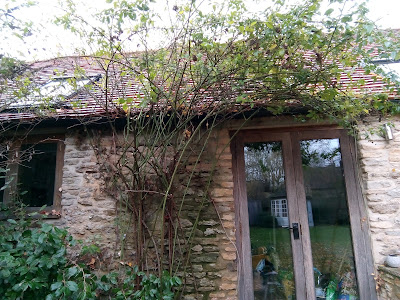I received a question a while back, (*waves* "Hi, Nicky!") concerning a lady wanting to create some planting areas in difficult spot, in a small communal garden.
Nicky said: "Unfortunately the area is heavily tree lined…lots of roots, it is shady, the grass area is mostly moss or bare and the soil is rock hard or non-existent."
This photo shows one corner of the area - complete with bicycle! - and you can really see the problems.Just look at those whopping great roots!
The tree roots are growing right on the surface: the thin covering of moss shows how deep the shade is, both by the fact that there is moss there at all, and by the fact that it is bare of grass: and it does look utterly compacted, because even the moss is struggling.
Nicky continued: "I think the best thing I can do is put some top soil down, so at least the poor plants have a fighting chance and probably put mulch on to keep some of the moisture in. "
Now, there are a couple of problems with that idea.
Firstly, putting additional soil over tree roots is rarely a good idea: when tree roots rise up to the surface like this - as per the photos - it's a response to the compression of their soil, probably from being in between a building, and a road.
Those exposed roots actually do perform a function: they contain lenticels, and the trees are using them to "breathe". So covering them in soil is not what the tree wants, plus, even if you do, they will work their way back up to the surface.
Next problem: you will have immense difficulty finding spots soft enough to dig into, because all the best spots are going to have whacking great tree roots running across them. This can make it hard to achieve a tidy, or stylish, or symmetrical, arrangement.
If the problem is "merely" cosmetic (I say that in quotes, because as gardeners, we care a great deal about what things look like!) then a shallow layer of something loose, like bark chippings, is fine: it covers up the ugly roots, makes the surface look homogenous, and because bark chippings are big, they form a matrix - rather than compacting down - which allows the roots to "breathe". In an area that shady, and that compacted, it's often better to give up on the grass, altogether... but adding a layer of topsoil, deep enough to plant into, is not the answer.
All this means that, as Nicky had already spotted, the only real answer is to use planters.
I would suggest combining those two ideas:- use above-ground planters, and surrounding the whole area with a fairly thin layer of bark chippings, so that the lady owner can stroll around to admire the planters, without getting muddy shoes.
The usual planter rules apply: get the biggest ones you can, get straight-sided ones wherever possible, avoid tapering ones at all costs: the key phrase is "trough" rather than "pot".
Make sure they have drainage holes: put them in place, taking some time to check the arrangements, because they will be too heavy to move once they are filled: then fill them with a 50-50 mix of cheap multipurpose bought-in compost, and either topsoil, or farmyard manure/organic matter, which will give the compost better water-holding properties.
Starting from scratch like this is a great opportunity to get matching planters: for a simple but stylish look, go for either all the same shape, or all the same colour: this avoids what I call "the fruit salad effect".
Talking of colour, painted planters also brighten up the place in winter, and as it is quite shady there, a splash of some contemporary colour on the planters might well be a welcome diversion, on a dark winter's day.
As the area is so very shady, a lot of plants might struggle to grow there, so planters offer another advantage, in that it's easy to remove/replace plants if they don't do well. A selection of shade-tolerant plants could be supported by cheap and replaceable bedding plants, both summer and winter, which also means that the owner can change it every year, if they wish.
One often-overlooked problem with planting under heavy tree cover is that of water - the presence of moss might suggest that the area is damp, so watering won't be necessary, but trees not only extract all the water from the soil around them, but they also act as umbrellas, keeping the rain off the planters below.
This isn't necessarily a big problem - a simple irrigation system could be installed.
Mind you, having to water the planters does give the owner an excellent excuse to go and walk around them every day!
So there you go, how to introduce planting into an otherwise very inhospitable environment!
Did you enjoy this article? Did you find it useful? Would you like me to answer your own, personal, gardening question? Become a Patron - just click here - and support me! Or use the Donate button for a one-off donation. If just 10% of my visitors gave me a pound a month, I'd be able to spend a lot more time answering all the questions!!






































